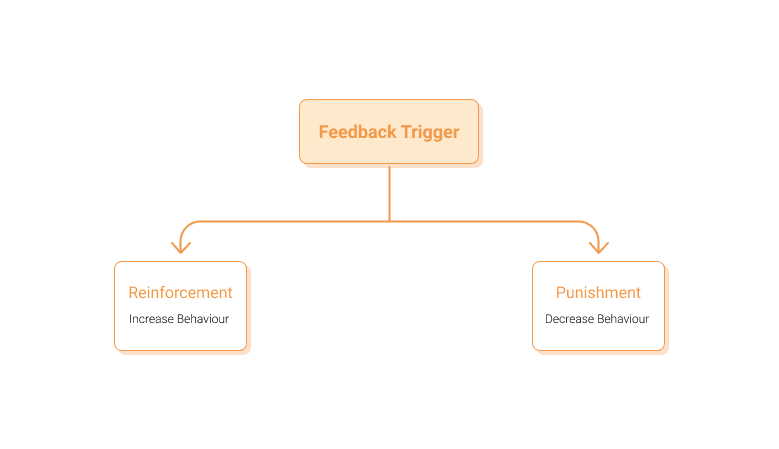The Deliberation and Decision
The purpose of deliberation is the decision, and the essence of a decision consists of selecting an option, in a certain context. The terms 'deliberation' and 'decision' are closely connected and can sometimes be interchangeable.
These terms imply that the decision-making person knows of :
- The situation that requires a decision
- Of the different options of action (responses)
- The consequences of each action (results)
A designer who doesn’t understand human psychologies is going to be no more successful than an architect who doesn’t understand physics - Joe Leech
The brain can quickly generate scenarios based on the available options. This means that when users select an option that doesn't match their imagined scenario, it causes frustration.
The opposite also happens, when the feedback matches their imaginative scenario a good feeling of reward is associated.

Feedback can trigger two possible outcomes: reinforcement (increasing behavior) and punishment (decreasing behavior).
These positive or negative outcomes can be defined by somatic markers, which are acquired through experience. They aid the decision-making process and its precision. This way, the learning process influences, and guides the behavior and decision-making of users for future interactions based on the past ones, and the somatic markers felt.
This theory was explored by António Damásio a neuroscientist and a professor of Psychology, Philosophy, and Neurology, at the University of Southern California.
So, positive emotional responses further reinforce the interactions with the products, they compensate/offset for the usability drawbacks and make the user more tolerant.
It's important to consider this data from a user experience perspective because punishment and reward are triggered by negative and positive somatic markers, respectively.
Let's imagine that the user achieves their goal but doesn't feel gratified due to the lack of UI feedback. That may unleash a negative impact on the somatic markers even though the goal was reached. The absence of reward may be perceived as punishment, becoming unpleasant and interfering with the learning process.
The learning process can be affected also when encountering the absence of punishment. This means that the user may get the wrong idea and what was supposed to be a punishment becomes a reward. Reward and punishment are learning constructs.

How the Somatic Market concept can be applied at a device interaction level?
UI elements related? Feedback notification: success message, error message…
After the somatic marker: analyze the learning process
According to Don Norman, a good design addresses 3 levels of how people perceive and process the reality around them. The Reflective, Behavioural, and Visceral level.
Let’s highlight the behavioral level: Is subconscious and has to do with our interaction with an object.
The behavioral level essentially refers to the emotions that users feel as a result of either accomplishing or failing to complete their goals.
After meeting or failing to complete their goals the factual knowledge is categorized. This categorization contributes to the decision-making process. The users classify the types of options, the type of results, and the connections between options and results. When confronted by a situation, this previous categorization allows us to quickly discover if a certain option or result is beneficial. That’s why it’s so important to correspond to the users’ expectations.
The IDF (Interaction Design Foundation) teacher Brian Whitworth at the “The Brain and Technology: Brain Science in Interface Design” course alleged that human feedback loops are controlled by three processing sub-systems: psychomotor, emotional, and intellectual.
All the sub-systems are important as they work simultaneously and in parallel, however, for the sake of this article let’s highlight the Emotional sub-system. This one is more adequate to support design from an HCI perspective and enable the user to understand purposes. Emotional learning primarily evolved to predict good and bad results for the user. That goes by the concept that we explored from António Damásio, the somatic learning process allows us to predict the good and bad results and are related to the most simple version from the Emotional sub-system.
But how to correspond to the users’ expectations?
- Use interactions and UI elements that create a Mere-Exposure Effect on users. This psychological term shows that people tend to develop a preference for something because they are familiar with it.
- Apply always the same approach: that regards the interactions or UI language. Think about consistency
- Apply Behavioural design principles: Make products/objects enable users to complete their goals with the minimum of difficulty and with little call for conscious effort. Is it easy and effective to use; does it do what we expect? If it does, this will give us a feeling of control and, therefore, one of pleasure and satisfaction.
With which exercises can we achieve that?
Card sorting
Because navigation is a crucial element in user interaction, you’ll want to create the information architecture that feels the most natural to your user.
User interviews
Allow to ask deeper questions about their habits, behaviors, and needs so that your design takes the path of least resistance.
Heuristic evaluation or Traditional user testing
Allow to find usability problems in a user interface design so that they can be attended to as part of an iterative design process.
These exercises will help to define: Structure, Behaviour, Language and Appearance. And help to align them with the users’ expectations.
Sources:
https://blog.prototypr.io/7-principal-psychological-phenomena-in-ux-design-1104e09fc974
https://www.creativebloq.com/web-design/how-learn-what-users-expect-your-design-71515712
https://www.interaction-design.org/literature/article/norman-s-three-levels-of-design
O Erro de Descartes — António Damásio
https://www.interaction-design.org/courses/the-brain-and-technology-brain-science-in-interface-design Cover photo by Ian Taylor on Unsplash